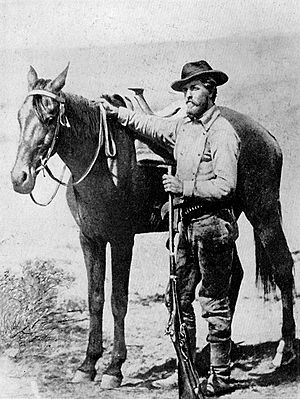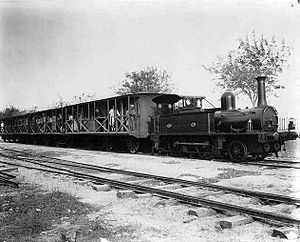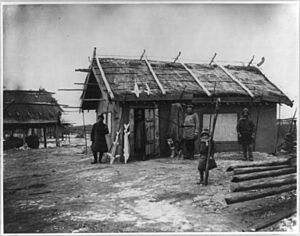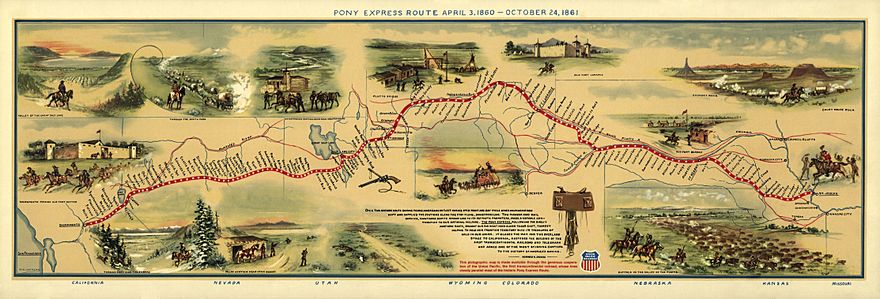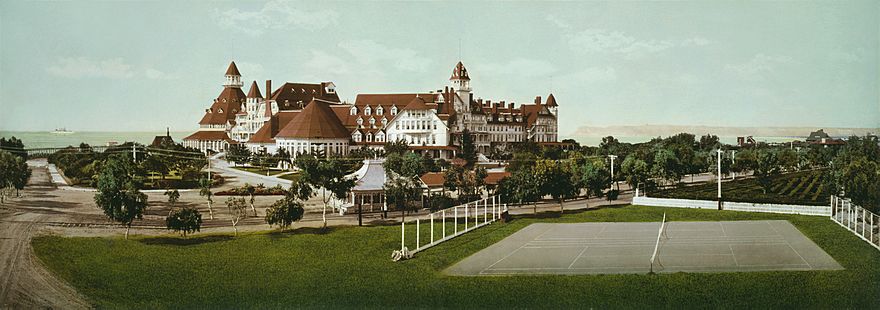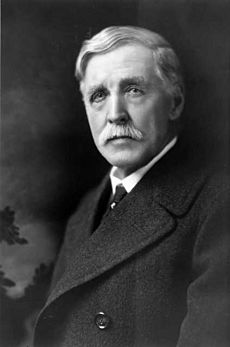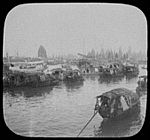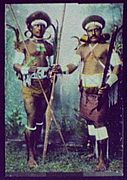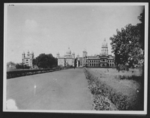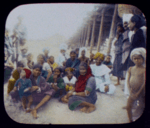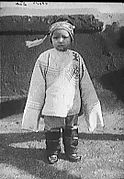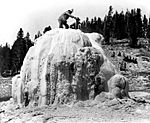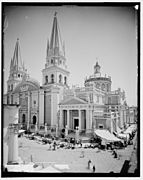William Henry Jackson facts for kids
Quick facts for kids
William Henry Jackson
|
|
|---|---|
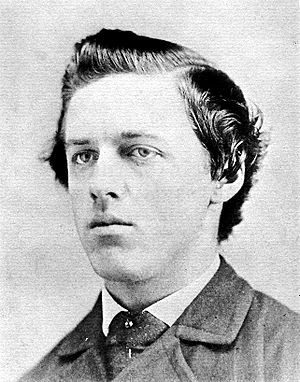
William Henry Jackson in 1862
|
|
| Born | April 4, 1843 |
| Died | June 30, 1942 (aged 99) |
| Resting place | Arlington National Cemetery |
| Occupation | Photographer Painter |
| Known for | "Mountain of the Holy Cross" photo |
William Henry Jackson (born April 4, 1843 – died June 30, 1942) was an American photographer, painter, and explorer. He is famous for his amazing pictures of the American West. He was also a veteran of the American Civil War. William Henry Jackson was the great-great nephew of Samuel Wilson, who is thought to be the inspiration for America's national symbol, Uncle Sam. He was also the great-grandfather of Bill Griffith, who created the "Zippy the Pinhead" comics.
Contents
Early Life and Adventures
Jackson was born in Keeseville, New York, on April 4, 1843. He was the first of seven children. His mother, Harriet Maria Allen, was a talented artist who painted with watercolors. William loved painting from a young age. By the time he was 19, he was a very skilled artist.
After growing up in Troy, New York, and Rutland, Vermont, Jackson joined the Union Army in October 1862. He was 19 years old. He spent his free time drawing sketches of his friends and army camp life. He sent these drawings home to his family to let them know he was safe. He served for nine months during the American Civil War, including the major Battle of Gettysburg. His army group left service in July 1863.
After the war, Jackson returned to Rutland and worked as a painter. He then decided to move west. In 1866, Jackson traveled by train to about 100 miles west of Omaha, Nebraska. From there, he joined a wagon train heading to Great Salt Lake. He worked as a "bullwhacker," guiding oxen on the Oregon Trail.
In 1867, Jackson and his brother Edward started a photography business in Omaha. Jackson often spent days traveling to photograph Native American tribes. He took famous pictures of the Osage, Oto, Pawnee, Winnebago, and Omaha peoples.
Capturing the West: William Henry Jackson's Photography
Documenting the Union Pacific Railroad
In 1869, the Union Pacific Railroad hired Jackson to photograph the beautiful scenery along their train routes. They used his pictures to promote train travel. His work caught the eye of Ferdinand Vandeveer Hayden, who was planning a scientific trip to explore the Yellowstone River area. Jackson was invited to join this important expedition.
Exploring Yellowstone National Park
The next year, Jackson joined the 1870 U.S. government survey of the Yellowstone River and Rocky Mountains. This survey was led by Ferdinand Hayden. Jackson was also part of the Hayden Geological Survey of 1871. This expedition helped lead to the creation of Yellowstone National Park. The painter Thomas Moran was also on this trip. Both artists worked together to record the Yellowstone region.
Hayden's surveys were yearly trips to map the unexplored western lands. They studied plants, animals, and geology (the study of rocks and earth). They also looked for good routes for travel. As the official photographer, Jackson took the first pictures of famous Western landmarks. These photos were very important. They helped convince the U.S. Congress in 1872 to make Yellowstone the first national park in the U.S.
Jackson's work with Hayden's survey made him known as one of the best explorers of the American continent. The survey team included Jackson, Moran, geologists, scientists, and even a small group of soldiers. They collected many plant and animal samples and other natural information.
Jackson used different types of cameras and glass plates for his photos. Conditions were often very hard. His photography used the collodion process. This meant he had to coat, expose, and develop fragile, heavy glass plates right there on the spot. He had to do this before the wet chemicals dried.
Taking one picture could take almost an hour. He had to guess the right exposure time, which could be anywhere from five seconds to twenty minutes. His team of 5 to 7 men carried all the heavy camera gear on mules. They also carried rifles for safety. Jackson's past experiences, like his military service and peaceful interactions with Native Americans, were very helpful.
The heavy glass plates and portable darkroom meant he could only take a limited number of photos on each trip. These pictures were taken in wild, roadless, and very difficult places. Once, a mule lost its footing, and Jackson lost a month's worth of photos. He had to go back into the mountains to retake the pictures. One of these was his famous view of the Mount of the Holy Cross.
Despite these challenges, Jackson returned with clear photographic proof of Western landmarks. These places had seemed like myths before. His photos showed the Tetons, Old Faithful and the rest of Yellowstone, Colorado's Rockies, and the Mount of the Holy Cross. Jackson's photographs of Yellowstone helped the U.S. Congress make it the first national park in March 1872.
Photography in Colorado and Beyond
In 1876, Jackson showed his photographs and clay models of Anasazi homes from Mesa Verde in Colorado. He displayed them at the Centennial Exposition in Philadelphia. He continued working on the Hayden Surveys until 1878.
Later, he opened a studio in Denver, Colorado. He created a huge collection of photos from around the world. In 1883, he started his own company, W.H. Jackson Photograph and Publishing Company. He was hired to photograph for Western state exhibits at the World's Columbian Exposition in Chicago in 1893.
Railroad and World Travel Photography
From 1890 to 1892, Jackson took photos for several railroad companies. These included the Baltimore and Ohio (B&O) and the New York Central. He used very large glass plates for these pictures. The B&O used his photos in their exhibit at the World's Columbian Exposition.
From 1894 to 1896, Jackson was the photographer for the World's Transportation Commission. This group traveled the world to document different ways people traveled. Jackson took over 900 photographs for this commission. These photos are now part of a collection at the Library of Congress.
The commission visited North Africa, the Middle East, India, Australia, East Asia, Russia, Europe, East Africa, and then South and Central America. Jackson's photos showed not only transportation but also the local environments and people.
William Henry Jackson as a Painter
Jackson was a very talented painter from a young age. He created many paintings of the American West throughout his life. He often said his mother, who was also a skilled painter, encouraged him greatly. His first job as an artist was in 1858. He worked for a photography studio in Troy, New York, where he retouched photos. Scotts Bluff National Monument in Nebraska has the largest collection of William Henry Jackson's paintings. In his later years, Jackson returned to illustrating.
Jackson's Publishing Career
After facing financial difficulties in 1893, Jackson was hired by Marshall Field to travel the world. His job was to photograph and collect items for a new museum in Chicago. His pictures and reports were published in Harper's Weekly.
In 1897, Jackson sold all his photo negatives and his services to the Detroit Publishing Company. This company had special rights to a color printing process called photochrom. Jackson joined the company in 1898 as president. He brought about 10,000 negatives with him. These negatives became the main part of the company's photo collection. They used these images to make everything from postcards to large panoramic prints.
By 1903, Jackson became the plant manager, which meant he traveled less. The company changed its name from Detroit Photographic Co. to Detroit Publishing Co. around 1905 or 1906. In the 1910s, the company also started selling copies of famous artworks. These were popular for education and home decoration.
At its busiest, the Detroit Publishing Company used 40,000 negatives. They sold seven million prints every year. Salesmen traveled, and catalogs were sent by mail. The company had offices in Detroit, New York, Los Angeles, London, and Zurich. They also sold photos at popular tourist spots. The company employed about forty artists and many traveling salesmen.
Sales of photos and postcards dropped during World War I. Also, new and cheaper printing methods appeared. Because of this, the Detroit Publishing Company closed down in 1924. Its assets were sold off in 1932.
Today, many of Jackson's Detroit photos are kept at the U.S. Library of Congress. This collection includes over 25,000 glass negatives and transparencies. Most of these are of the eastern United States. There are also about 900 large "Mammoth Plate" photos. These were taken along railroad lines in the U.S. and Mexico in the 1880s and 1890s. The collection also has views of California, Wyoming, and the Canadian Rocky Mountains.
In 1936, Edsel Ford, with help from his father Henry Ford, bought Jackson's 40,000 negatives. These went to "The Edison Institute," now known as The Henry Ford in Dearborn, Michigan. Eventually, Jackson's negatives were split between the Colorado Historical Society (for views west of the Mississippi River) and the Library of Congress (for all other views).
Later Life and Legacy
Jackson moved to Washington, D.C., in 1924. There, he created large paintings (murals) of the Old West for the new U.S. Department of the Interior building. He also worked as a technical advisor for the movie Gone with the Wind.
William Henry Jackson also attended the 75th anniversary of the Battle of Gettysburg in July 1938. He was one of the last surviving Civil War veterans.
Jackson died in New York City in 1942 at the age of 99. The Explorer's Club honored him for his 80,000 photographs of the American West. He was also remembered by the Adventurers' Club of New York, where he was an active member. The SS William H Jackson steamship was named after him and was used in 1945. He was buried at Arlington National Cemetery.
Mount Jackson, a mountain in Yellowstone National Park, is named in his honor. In 1982, Jackson was added to the International Photography Hall of Fame and Museum.
Gallery
- Works of William Henry Jackson
-
Muddy Pond, Rutland VT, 1861. Oil painting, 36' x 24', Vermont.
-
F.V. Hayden Expedition, Wyoming.
-
A street market in Mexico City, 1884–1885.
-
Canton harbor crowded with sampans.
-
Solomon Islands warriors, 1895.
-
Madras, India, 1895.
-
Group of Tamil natives at the pier, 1895.
-
Denver, Colorado, 1885.
-
Chinese American child in embroidered jacket, 1900.
-
Shirley Plantation, James River, Virginia, 1900–1906.
-
1899 photograph of El Capitan.
-
Lone Star Geyser, Yellowstone, 1878.
See also
 In Spanish: William Henry Jackson para niños
In Spanish: William Henry Jackson para niños



